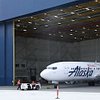The upcoming release of “The Incredibles 2,” the highly anticipated sequel to 2004’s “The Incredibles,” is giving Alaska Airlines a chance to draw attention to the movie and their fleet. The airline recently unveiled a special “Incredibles 2” themed 737-800 that will be flying the friendly skies.

Advertising and Aviation
Alaska Airlines is taking full advantage of the chance to celebrate a movie that fans of the original Pixar film have been looking forward to for 14 years. The special edition plane, which has tail number N519AS, features the entire superhero family on the fuselage. As the plane makes it way from destination to destination, those who look up will have a chance to see the Parr family in action poses. The airline held a special event on Aviation Day in order to show fans the new design.

The airline’s decision to feature characters from “The Incredibles 2” comes at a considerable cost. While this move is bound to draw more attention to Alaska Airlines and also boost advertising for the upcoming movie, getting planes fitted with special livery is no small or inexpensive feat. In fact, there are significant costs and complexities that have to be taken into consideration.
Safety Factors and Special Considerations for Vinyl Wraps
When airlines decide to have their fleet wrapped with a special design, this ends up being a major task that must be handled by those who have experience and training. Airplane wraps are made of vinyl material (Polyvinyl chloride - PVC) where one side has a strong adhesive side and the other side has a design printed onto it. Most vinyl wraps for vehicles are manufactured by 3M and Avery. Planes that feature vinyl wraps can turn into potential safety hazards if these wrappings are applied incorrectly. An enormous vinyl wrap that peels off of an airplane’s surface could cause serious and possible deadly injuries to those below it.
Vinyl wrappings have to be durable, but they also need to be versatile enough to handle temperature extremes. Planes that have these wrappings can go from runway temperatures above 100 degrees to temperatures in the air at cruising altitude, which can drop to 50 degrees below zero. Since vinyl stretches and shrinks along with these temperature changes, those who apply it have to make sure that it fits securely on the plane’s surface.
Putting on vinyl wraps can be done in a much shorter timeframe than painting a plane’s surface, but the cost overall is still high. This is mainly due to the expertise that is needed to handle this task properly.
The Challenges of Painting an Airplane
Painting an airplane does not come with the same risks as putting on vinyl wrappings. Airlines don’t have to worry about paint peeling off and causing injuries as they do with wrappings. The paint that is used is also designed to withstand extreme temperatures on the ground and in the air. However, the task of painting an entire plane is much more time-consuming and expensive than using vinyl wraps.
This process starts with the painting crew strips the airplane, which can take more than 24 hours in some cases. Once this is done, the workers apply primer to the plane's surface. Once the primer has dried, the paint is applied in layers, which usually requires a crew of up to 15 people. In general, painting airplanes with a special design can take up to 10 days. When the painting is done, the airplane has to dry for about a week or less. Airlines have to take this downtime into consideration when deciding whether or not to have special livery done with paint or vinyl wrapping.
Check out a great time lapse video of Alaska Airlines wrapping their 737-800 with the Incredibles 2 livery:










